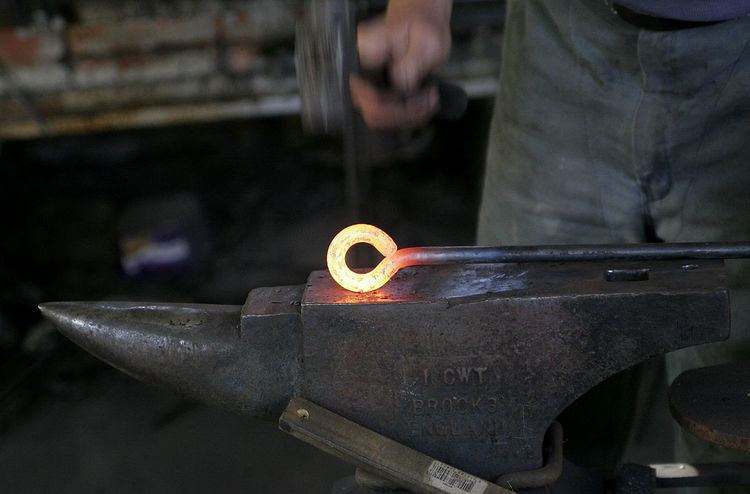 | ||
The emissivity of the surface of a material is its effectiveness in emitting energy as thermal radiation. Thermal radiation is electromagnetic radiation and it may include both visible radiation (light) and infrared radiation, which is not visible to human eyes. The thermal radiation from very hot objects (see photograph) is easily visible to the eye. Quantitatively, emissivity is the ratio of the thermal radiation from a surface to the radiation from an ideal black surface at the same temperature as given by the Stefan–Boltzmann law. The ratio varies from 0 to 1. The surface of a black object emits thermal radiation at the rate of approximately 448 watts per square meter at room temperature (25 °C, 298.15 K); real objects with emissivities less than 1.0 emit radiation at correspondingly lower rates.
Contents
- Hemispherical emissivity
- Spectral hemispherical emissivity
- Directional emissivity
- Spectral directional emissivity
- Emissivities of common surfaces
- Emissivity and absorptivity
- Directional spectral emissivity
- Emissivity and emittance
- References
Emissivities are important in several contexts:
Hemispherical emissivity
Hemispherical emissivity of a surface, denoted ε, is defined as
where
Spectral hemispherical emissivity
Spectral hemispherical emissivity in frequency and spectral hemispherical emissivity in wavelength of a surface, denoted εν and ελ respectively, are defined as
where
Directional emissivity
Directional emissivity of a surface, denoted εΩ, is defined as
where
Spectral directional emissivity
Spectral directional emissivity in frequency and spectral directional emissivity in wavelength of a surface, denoted εν,Ω and ελ,Ω respectively, are defined as
where
Emissivities of common surfaces
Emissivities ε can be measured using simple devices such as Leslie's Cube in conjunction with a thermal radiation detector such as a thermopile or a bolometer. The apparatus compares the thermal radiation from a surface to be tested with the thermal radiation from a nearly ideal, black sample. The detectors are essentially black absorbers with very sensitive thermometers that record the detector's temperature rise when exposed to thermal radiation. For measuring room temperature emissivities, the detectors must absorb thermal radiation completely at infrared wavelengths near 10×10−6 meters. Visible light has a wavelength range of about 0.4 to 0.7×10−6 meters from violet to deep red.
Emissivity measurements for many surfaces are compiled in many handbooks and texts. Some of these are listed in the following table.
Notes:
- These emissivities are the total hemispherical emissivities from the surfaces.
- The values of the emissivities apply to materials that are optically thick. This means that the absorptivity at the wavelengths typical of thermal radiation doesn't depend on the thickness of the material. Very thin materials emit less thermal radiation than thicker materials.
Emissivity and absorptivity
There is a fundamental relationship (Gustav Kirchhoff's 1859 law of thermal radiation) that equates the emissivity of a surface with its absorption of incident radiation (the "absorptivity" of a surface). Kirchhoff's Law explains why emissivities cannot exceed 1, since the largest absorptivity - corresponding to complete absorption of all incident light by a truly black object - is also 1. Mirror-like, metallic surfaces that reflect light will thus have low emissivities, since the reflected light isn't absorbed. A polished silver surface has an emissivity of about 0.02 near room temperature. Black soot absorbs thermal radiation very well; it has an emissivity as large as 0.97, and hence soot is a fair approximation to an ideal black body.
With the exception of bare, polished metals, the appearance of a surface to the eye is not a good guide to emissivities near room temperature. Thus white paint absorbs very little visible light. However, at an infrared wavelength of 10x10−6 meters, paint absorbs light very well, and has a high emissivity. Similarly, pure water absorbs very little visible light, but water is nonetheless a strong infrared absorber and has a correspondingly high emissivity.
Directional spectral emissivity
In addition to the total hemispherical emissivities compiled in the table above, a more complex "directional spectral emissivity" can also be measured. This emissivity depends upon the wavelength and upon the angle of the outgoing thermal radiation. Kirchhoff's law actually applies exactly to this more complex emissivity: the emissivity for thermal radiation emerging in a particular direction and at a particular wavelength matches the absorptivity for incident light at the same wavelength and angle. The total hemispherical emissivity is a weighted average of this directional spectral emissivity; the average is described by textbooks on "radiative heat transfer".
Emissivity and emittance
Emittance (or emissive power) is the total amount of thermal energy emitted per unit area per unit time for all possible wavelengths. Emissivity of a body at a given temperature is the ratio of the total emissive power of a body to the total emissive power of a perfectly black body at that temperature.
The term emissivity is generally used to describe a simple, homogeneous surface such as silver. Similar terms, emittance and thermal emittance, are used to describe thermal radiation measurements on complex surfaces such as insulation products.
